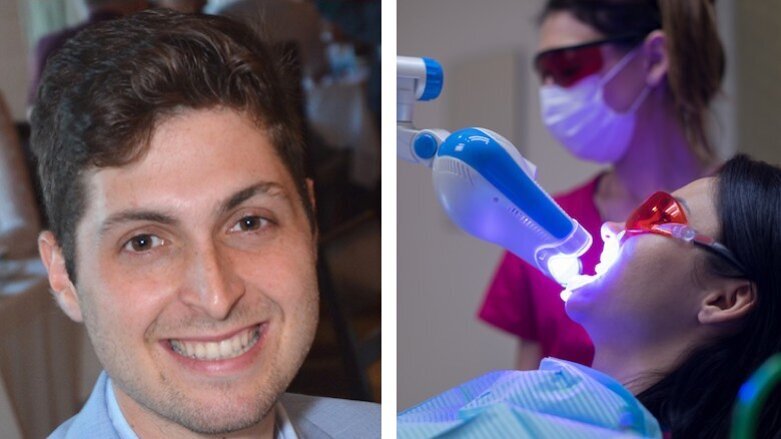Until recently, performing a tooth whitening procedure on British dental patients under the age of 18 was illegal. However, recent changes in the position of the General Dental Council (GDC) on this issue have cleared the way for minors to receive this treatment under specific conditions. Dental Tribune International spoke with Dr Joseph Greenwall-Cohen from the University of Manchester’s Division of Dentistry about what these changes mean, and what effects whitening can have on the teeth of adolescents. Greenwall-Cohen has recently authored a paper on the topic, titled “Tooth whitening for the under-18-year-old patient”, that was published in the British Dental Journal.
Does the general tooth whitening legislation in the UK differ from that of the EU?
The EU differs in its approach to tooth bleaching for people under 18 years of age in that this is currently still not allowed. EU Council Directive 2011/84/EU states that products containing more than 0.1 per cent hydrogen peroxide are not to be used on those in this age range. This is unfortunate, as tooth discolorations can have a psychosocial effect on the patient’s life, and successful bleaching of the discoloration can help prevent further issues. This leaves dentists with an ethical dilemma between providing the most appropriate treatment for a patient and the legal statute of the region.
The GDC’s position on the EU regulation states that products containing greater than 0.1 per cent hydrogen peroxide can be used on patients under 18 years of age when intended wholly for the purpose of treating or preventing disease. This enables dentists in the UK to carry out bleaching on these patients in certain clinical situations.
However, different countries in Europe take different stances with regard to the EU council directive, and it would be worthwhile to consult indemnity providers if unsure.
As you mentioned, a revised position statement from the GDC states that tooth whitening can be performed on patients under 18 years of age with the express purpose of treating or preventing disease. Was whitening for these patients allowed prior to this statement, and how can whitening help to treat or prevent disease?
Prior to the GDC amendment, use of 0.1 per cent hydrogen peroxide on patients under 18 years of age was forbidden, regardless of the clinical situation. This left the profession in an extremely precarious situation, as more invasive and destructive procedures, such as direct and indirect restoration, were allowed on this patient group, while bleaching, which forms the cornerstone of minimally invasive aesthetic dentistry, was not. Why should it be appropriate to enter a young patient into the restorative cycle so early in his or her dental life just to avoid legal confrontation? Thankfully, this was changed and now tooth bleaching can be used when intended wholly for the purpose of treating or preventing disease.
In the article, we discuss how it was traditionally recommended in the UK to contact indemnity providers prior to undertaking the bleaching procedure on such patients. This recommendation not only is one of extreme inconvenience, but also detracts from the very nature of our profession, as diagnosing dental disease is the foundation of being a dental professional.
In the article, we list ten specific clinical situations in which bleaching for adolescent patients would be indicated. However, it is also essential to appreciate the potential psychological and psychosocial effects of any discoloration, and therefore in certain situations the importance in treating these discolorations is to minimise associated mental health conditions and bullying.
Furthermore, nowadays there is also much research to show the anti-cariogenic and antibacterial effects of carbamide peroxide. A previous article I wrote for Dental Update [Editor's note: Dental Update is a UK-based dental journal] showed the use of carbamide peroxide to aid in oral hygiene and to minimise dental disease.
Are there any risk factors specific to whitening the teeth of patients under 18 years of age?
The main risk factor with custom tray-applied bleaching is that of sensitivity. This occurs in 15–65 per cent of all patients undergoing bleaching. It was conventionally thought that this would be greater in the younger patient owing to the proportionally larger pulp chambers in the teeth of the adolescent patient. However, research by Prof. Kevin Donly has shown that this is not the case, and sensitivity is actually less frequently experienced in the adolescent patient. Donly hypothesised that this was a result of the increased enamel quantity and quality of adolescent teeth and the larger pulp complexes in adolescent patients’ teeth, which allow for faster recovery from the acute inflammation experienced during a sensitivity episode.
Gingival irritation is also a risk factor for custom tray-applied bleaching in the under-18-year-old patient. However, no difference in prevalence has been noted compared with gingival irritation experienced in the adult patient. Both sensitivity and gingival irritation in the adolescent patient are manageable, and management is discussed in the article.
Is there any particular age range in which tooth whitening should not be practised?
Prof. Van Haywood [Editor's note: Prof. Haywood is a widely-published expert on the topic of tooth whitening] has recommended age 10–14 as the time when tooth whitening should commence for the adolescent patient. However, it is essential that each case should be assessed individually. Factors such as the severity of discoloration and the effect of the discoloration psychosocially on the individual need to be considered when determining the correct time to undertake bleaching.
Are Britons able to purchase the same tooth whitening products themselves that would be used in a dental practice, or are there certain prohibitions?
Britons are only able to purchase products containing 0.1–6 per cent hydrogen peroxide through a dental professional after a dental examination. However, what we see nowadays is a range of non-peroxide-containing products being sold by all major retailers. These products contain a range of active ingredients, with the most common being sodium chlorite. Although there is limited research on these products, the research we do have shows that these products cause significant reductions in Vickers microhardness and surface alterations in scanning electron micrograph studies, thus having a potentially damaging effect.
Thank you very much for the interview.
Tags:
Today, millions of disadvantaged children worldwide suffer from untreated dental diseases and tooth decay. For most of them, there is no possibility of ...
COVID-19 has had a significant impact on our professional life, yet the aftermath of the pandemic and its consequences for our future are still unclear. ...
London-based company Dental Focus has been advising UK dentists on how to attract new patients through online marketing since 2001. For Dental Tribune ...
GERRARDS CROSS, UK: In order to improve its activities in the promotion of endodontic treatment, the British Endodontic Society is currently inviting ...
For Dr Victoria Sampson, the connection between oral and systemic health is of central concern when dealing with her dental patients. She employs biomarkers...
LONDON, UK: Though teething is a difficult experience for both parents and their babies, a judicious decision-making process should be employed when ...
On 10 November, experts and researchers from around the UK met in London for a summit organised by the British Dental Association (BDA) to discuss what ...
It would be hard to find two more disparate figures in history than physicist Albert Einstein and American Civil War general Robert E. Lee—who has been ...
The recent Nobel Biocare Global Symposium saw many of the world’s leading voices on implantology and digital dentistry gather in the Spanish capital of ...
Live webinar
Wed. 14 January 2026
5:00 pm UTC (London)
Dr. Théo Laplane, Dr. Robert Gottlander DDS
Live webinar
Fri. 16 January 2026
5:00 pm UTC (London)
Live webinar
Mon. 19 January 2026
6:00 pm UTC (London)
Philipp Kopp, Michael Seeber
Live webinar
Thu. 22 January 2026
2:00 pm UTC (London)
Prof. Judith Jones D.D.S; M.P.H., Prof. Kakuhiro Fukai D.D.S., Ph.D, Dr. Bathsheba (Bethy) Turton
Live webinar
Thu. 22 January 2026
7:00 pm UTC (London)
Dr. Nicola M. Grande DDS, PhD
Live webinar
Wed. 28 January 2026
1:00 pm UTC (London)
Live webinar
Wed. 28 January 2026
4:00 pm UTC (London)
Prof. Dr. Jan-Frederik Güth



 Austria / Österreich
Austria / Österreich
 Bosnia and Herzegovina / Босна и Херцеговина
Bosnia and Herzegovina / Босна и Херцеговина
 Bulgaria / България
Bulgaria / България
 Croatia / Hrvatska
Croatia / Hrvatska
 Czech Republic & Slovakia / Česká republika & Slovensko
Czech Republic & Slovakia / Česká republika & Slovensko
 France / France
France / France
 Germany / Deutschland
Germany / Deutschland
 Greece / ΕΛΛΑΔΑ
Greece / ΕΛΛΑΔΑ
 Hungary / Hungary
Hungary / Hungary
 Italy / Italia
Italy / Italia
 Netherlands / Nederland
Netherlands / Nederland
 Nordic / Nordic
Nordic / Nordic
 Poland / Polska
Poland / Polska
 Portugal / Portugal
Portugal / Portugal
 Romania & Moldova / România & Moldova
Romania & Moldova / România & Moldova
 Slovenia / Slovenija
Slovenia / Slovenija
 Serbia & Montenegro / Србија и Црна Гора
Serbia & Montenegro / Србија и Црна Гора
 Spain / España
Spain / España
 Switzerland / Schweiz
Switzerland / Schweiz
 Turkey / Türkiye
Turkey / Türkiye
 UK & Ireland / UK & Ireland
UK & Ireland / UK & Ireland
 International / International
International / International
 Brazil / Brasil
Brazil / Brasil
 Canada / Canada
Canada / Canada
 Latin America / Latinoamérica
Latin America / Latinoamérica
 USA / USA
USA / USA
 China / 中国
China / 中国
 India / भारत गणराज्य
India / भारत गणराज्य
 Pakistan / Pākistān
Pakistan / Pākistān
 Vietnam / Việt Nam
Vietnam / Việt Nam
 ASEAN / ASEAN
ASEAN / ASEAN
 Israel / מְדִינַת יִשְׂרָאֵל
Israel / מְדִינַת יִשְׂרָאֵל
 Algeria, Morocco & Tunisia / الجزائر والمغرب وتونس
Algeria, Morocco & Tunisia / الجزائر والمغرب وتونس
 Middle East / Middle East
Middle East / Middle East




















































